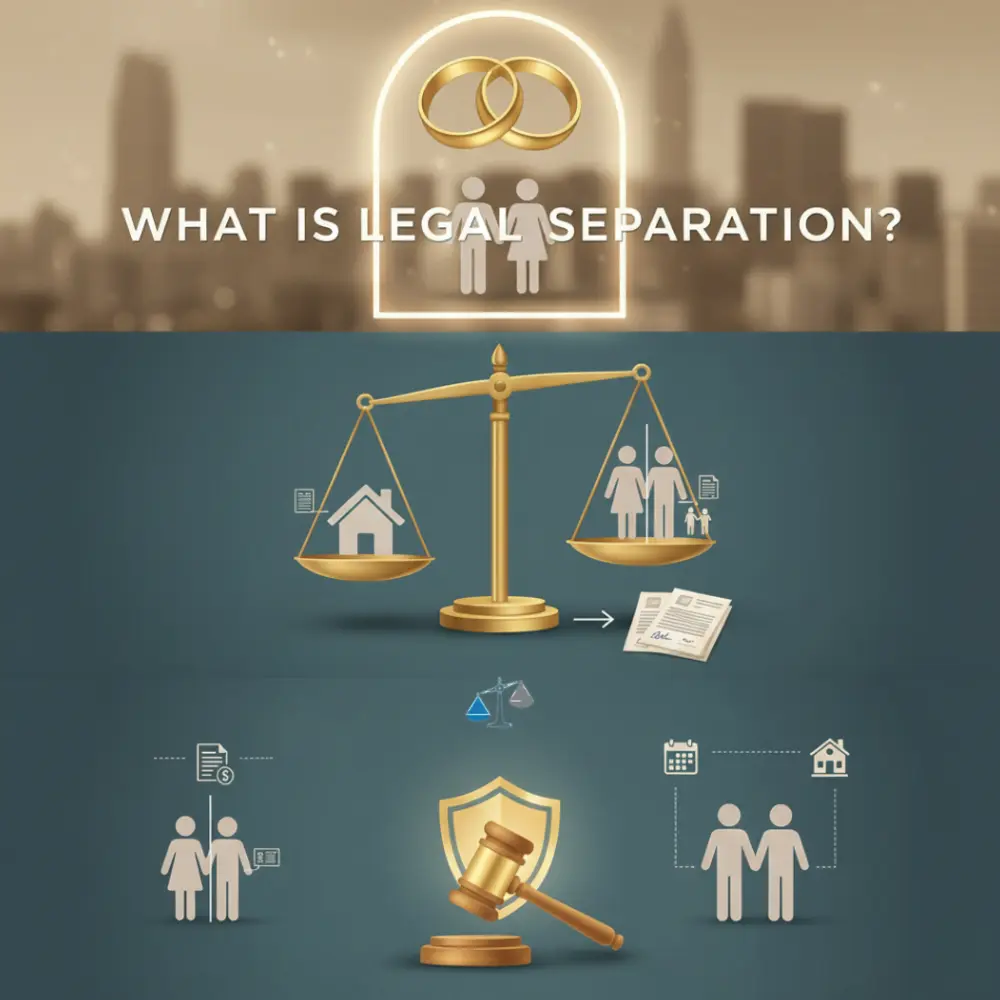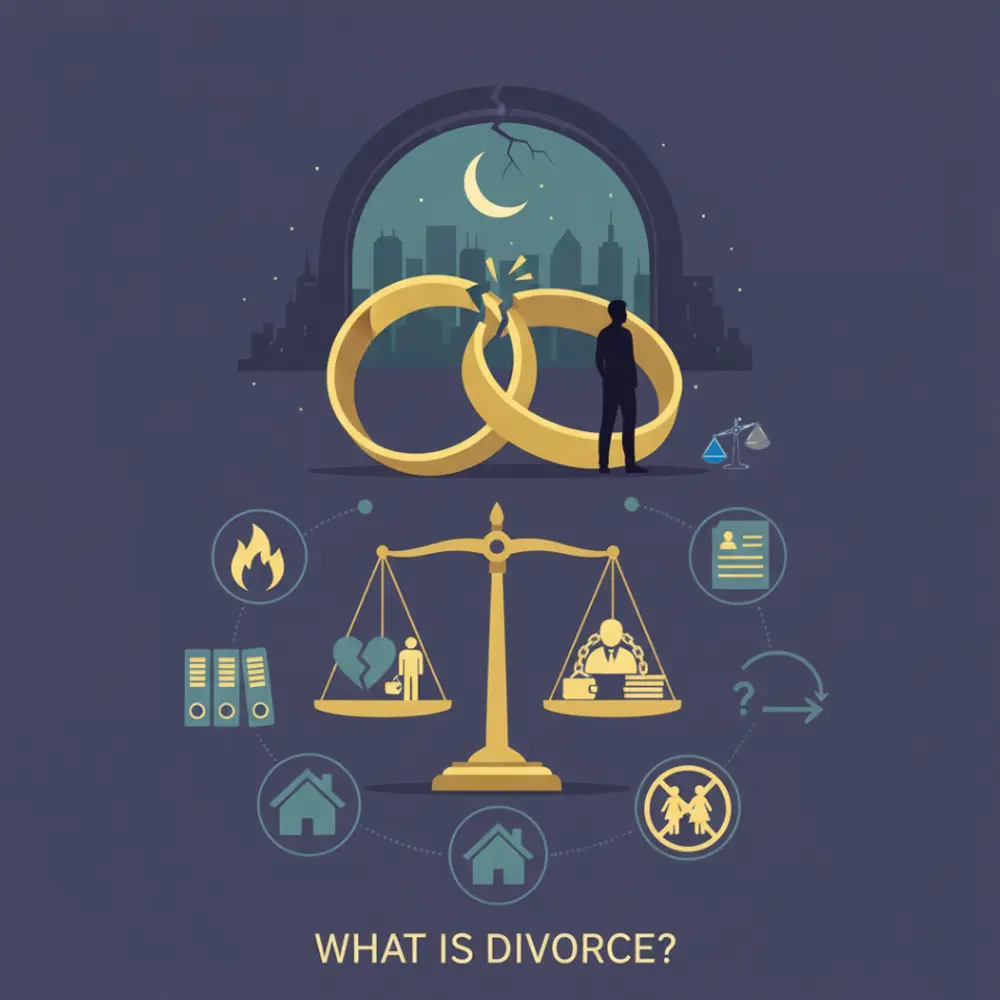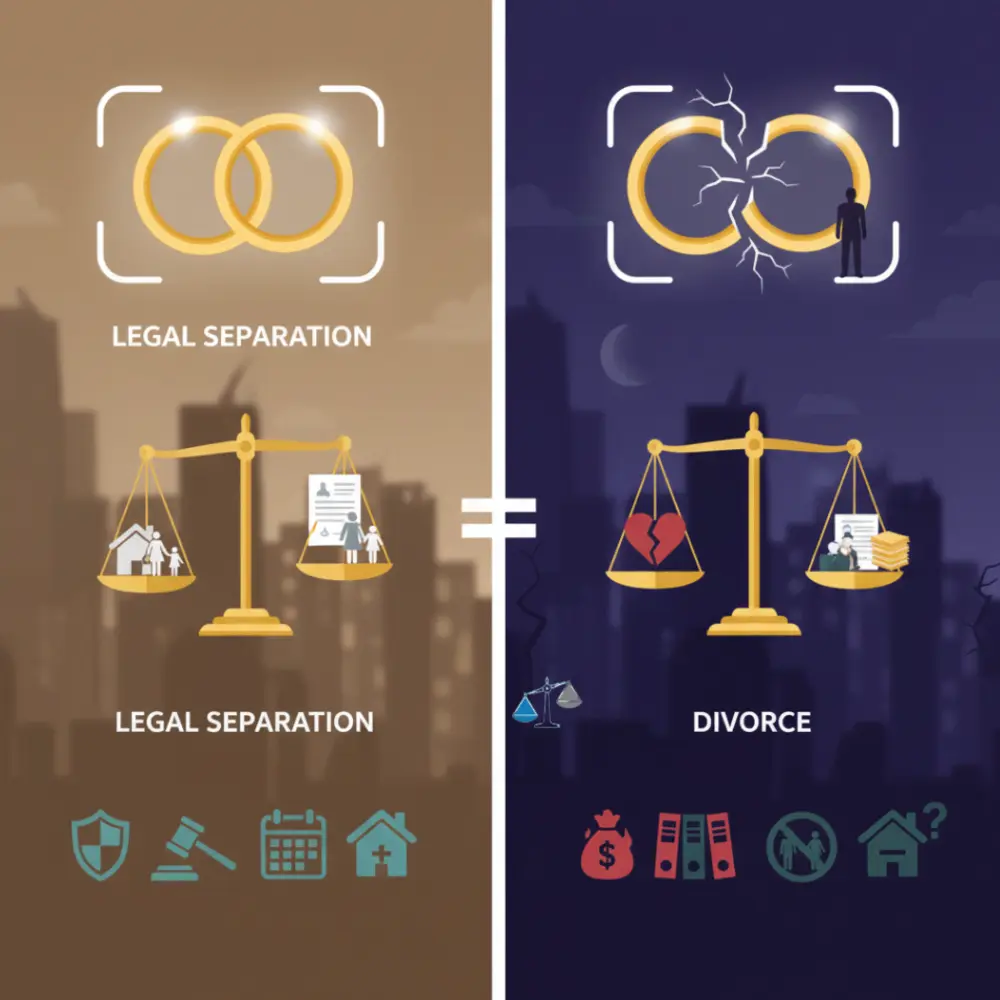Legal Separation vs Divorce: Pros and Cons Compared

When a marriage faces serious challenges, couples often find themselves deciding between legal separation vs divorce. Both are legal processes that affect finances, responsibilities, and personal freedoms, but they are not the same. A legal separation allows spouses to live apart while remaining legally married, whereas a divorce permanently ends the marriage. Understanding the advantages and disadvantages of each option can help couples make the best decision for their circumstances.
What Is Legal Separation?
A legal separation is a court-recognized arrangement where a married couple lives apart but remains legally married. Unlike divorce, it does not dissolve the marriage, meaning the spouses are still legally bound but can establish rules for finances, custody, and living arrangements.

In practice, legal separation allows couples to live independently while maintaining their marital status. Courts typically issue a formal decree that outlines responsibilities such as property division, spousal support, child custody, and visitation rights. This decree functions similarly to a divorce settlement but keeps the marriage intact.
Reasons Couples Choose Legal Separation
- Religious or cultural reasons – Some faiths prohibit divorce, making separation a more acceptable option.
- Financial benefits – Couples may remain eligible for health insurance, military benefits, or tax advantages.
- Possibility of reconciliation – Legal separation gives space for couples to work on their relationship without fully ending the marriage.
- Trial period – Some couples use separation as a step toward deciding whether divorce is the right choice.
Example Scenario
Consider a couple struggling with financial and emotional stress. They decide to legally separate so they can live apart and manage responsibilities individually. However, since they remain legally married, they both retain access to shared health insurance benefits.
In short, legal separation allows spouses to live apart under court supervision while keeping the marriage legally intact.
What Is Divorce?
A divorce is the legal process that permanently ends a marriage, dissolving all marital rights and responsibilities between spouses. Unlike legal separation, divorce completely severs the legal bond, allowing each person to remarry and move forward independently.

During divorce proceedings, courts typically determine how to divide property, debts, custody, child support, and spousal support. Once finalized, the marriage is legally terminated, and both individuals return to single status.
Key Features of Divorce
- Permanent dissolution – The marriage is legally ended, and spouses are no longer bound to each other.
- Property division – Courts distribute marital assets and debts according to state laws (community property vs. equitable distribution).
- Custody and support – Child custody, visitation, child support, and alimony are formally established.
- Right to remarry – Divorce restores legal freedom to enter into a new marriage.
Example Scenario
Imagine a couple who has tried counseling and separation but cannot resolve their differences. They choose divorce, which legally divides their property and responsibilities. After the process is complete, both spouses are free to live independently and remarry in the future.
In short, divorce is the permanent legal end of a marriage, providing a clean break for both spouses.
Key Legal Differences Between Separation and Divorce
The main legal difference is that divorce ends the marriage entirely, while legal separation keeps the marriage intact but defines each spouse’s rights and obligations while living apart. This distinction affects property rights, marital status, and future legal options.

Legal Separation
- Marital status – Spouses remain legally married.
- Property and debt – Courts can divide assets and debts but the couple is still considered married under the law.
- Benefits – Spouses may continue sharing health insurance, tax advantages, or military benefits (depending on policies).
- Remarriage – Neither spouse can remarry unless they file for divorce.
Divorce
- Marital status – Legally ends the marriage, and both parties return to single status.
- Property and debt – Assets and debts are permanently divided; financial ties are legally severed.
- Benefits – Spouses lose access to benefits tied to marriage, such as insurance coverage through the other spouse.
- Remarriage – Each spouse is free to remarry or form new legal unions.
Practical Contrast
- Legal separation is often chosen by couples uncertain about divorce or seeking financial/religious advantages while living apart.
- Divorce is the definitive option when couples are certain the marriage is over and want complete independence.
In short, separation maintains the marriage legally, while divorce dissolves it permanently.
Financial Implications: Property, Debt, and Support
The key financial difference is that divorce permanently divides assets and debts, while legal separation divides them temporarily under court supervision while keeping the marriage intact. Both processes address property, debt, and support, but the long-term consequences differ.
Property Division
- Legal Separation: Courts can issue orders dividing property and outlining who is responsible for certain assets or debts, but spouses may still retain marital rights (like inheritance) unless otherwise waived.
- Divorce: Property division is final. Once the divorce decree is issued, marital property is permanently distributed under state law.
Debt Responsibility
- Legal Separation: Debt responsibility can be assigned, but spouses may still remain legally tied in some financial contexts (for example, joint credit accounts).
- Divorce: Debts are permanently separated. Creditors may still pursue both spouses for joint debts, but legally, each spouse has individual responsibility moving forward.
Spousal Support (Alimony)
- Legal Separation: Courts may order temporary or ongoing spousal support while the marriage continues.
- Divorce: Spousal support may also be awarded, but it typically ends when the paying spouse dies or the receiving spouse remarries.
Example Scenario
Consider a couple who legally separates for religious reasons. The court divides their property and assigns debt responsibility but keeps them married. If they later choose divorce, those divisions become final, and marital rights such as inheritance are terminated.
In short, separation manages finances temporarily within a continuing marriage, while divorce permanently severs financial ties.
Impact on Children and Custody Arrangements
The primary difference is that both legal separation and divorce require custody and support arrangements, but divorce permanently restructures the family unit, while legal separation keeps the marriage intact with ongoing parental ties.
Custody in Legal Separation
- Parents remain legally married but live apart.
- Courts issue custody, visitation, and child support orders similar to divorce.
- Because the marriage is not dissolved, some benefits (like inheritance rights through parents) remain unchanged for the child.
- Separation can serve as a trial period, giving parents time to test custody arrangements before deciding on divorce.
Custody in Divorce
- The court formally determines legal custody (decision-making authority) and physical custody (where the child lives).
- Child support is calculated based on income, custody schedules, and state guidelines.
- Custody arrangements are final but can be modified if circumstances change significantly (e.g., relocation, changes in a parent’s stability).
- Divorce legally redefines the parents’ roles, establishing them as two separate households.
Emotional and Practical Considerations
- Legal Separation: May reduce the emotional impact on children if parents present the separation as temporary or reversible.
- Divorce: Provides clarity and finality, which may help children adapt in the long run, but it can also create more initial stress.
Example Scenario
A couple with two children chooses legal separation to live apart while they work on marital issues. The court sets custody and child support orders, but the children still see their parents as legally married. Later, if the parents decide divorce is inevitable, the custody arrangement can be formalized in the divorce decree.
In short, both separation and divorce involve custody decisions, but divorce finalizes the family restructuring, while separation leaves the marriage legally intact.
Religious, Cultural, and Personal Considerations
The key point is that legal separation is often chosen when divorce conflicts with religious, cultural, or personal values, while divorce is the option when couples want a complete legal and personal break.
Religious Considerations
- Legal Separation: Many religions discourage or forbid divorce. In such cases, separation offers a way for couples to live apart while still respecting their faith’s teachings.
- Divorce: May be seen as a violation of religious principles, making it unacceptable for some couples despite serious marital difficulties.
Cultural Factors
- In certain cultures, divorce carries social stigma, affecting family honor or community standing.
- Legal separation provides an alternative that allows independence without the full societal consequences of divorce.
Personal and Emotional Considerations
- Legal Separation: Can be a middle ground for couples unsure about ending the marriage, offering time apart while leaving the door open for reconciliation.
- Divorce: Provides closure and emotional finality, which may be healthier for couples certain that the relationship cannot be repaired.
Example Scenario
A couple from a traditional religious background decides to separate legally instead of divorcing. This allows them to live apart, divide responsibilities, and raise children under structured custody arrangements—without facing the cultural backlash that a divorce might trigger in their community.
In short, legal separation often aligns better with religious or cultural values, while divorce provides a definitive legal and emotional conclusion.
Pros and Cons of Legal Separation
The main advantage of legal separation is that it allows couples to live apart with court-ordered arrangements while keeping the marriage intact, but the downside is that it does not provide the finality and independence of divorce.
Pros of Legal Separation
- Maintains marital status – Couples remain legally married, which may be important for religious or cultural reasons.
- Financial benefits – Spouses may still access health insurance, tax benefits, or military benefits depending on policies.
- Trial option – Separation gives couples time to evaluate whether reconciliation or divorce is best.
- Structured arrangement – Court orders provide clarity on finances, custody, and support without ending the marriage.
Cons of Legal Separation
- Not a full break – Spouses remain legally tied, meaning neither can remarry.
- Ongoing financial connection – Debts or financial obligations may still affect both parties.
- Potential complexity – Separation agreements can be as detailed and costly as divorce settlements.
- Uncertain future – If reconciliation fails, couples may need to go through the divorce process later, adding time and expense.
Example Scenario
Two spouses with children choose legal separation because their religion forbids divorce. The arrangement allows them to live apart and manage custody under court supervision. However, if either wants to remarry in the future, they must still go through a full divorce process.
In short, legal separation is a flexible alternative to divorce that preserves marital status but may prolong financial and emotional entanglement.
Pros and Cons of Divorce
The main advantage of divorce is that it provides a permanent legal and personal break, but the downside is that it can be emotionally and financially costly.
Pros of Divorce
- Permanent resolution – Fully ends the marriage, eliminating ongoing marital ties.
- Freedom to remarry – Both parties regain the legal right to marry someone else.
- Financial independence – Assets and debts are permanently divided, preventing future entanglements.
- Emotional closure – Divorce provides a clear endpoint, allowing spouses to move on with their lives.
- Reduced conflict over time – While the process may be difficult, finality often reduces long-term disputes.
Cons of Divorce
- Loss of benefits – Spouses lose health insurance, military, or tax benefits tied to marriage.
- Emotional stress – Divorce can cause grief, anger, or guilt, particularly if children are involved.
- Financial burden – Legal fees, asset division, and support obligations can be expensive.
- Impact on children – The finality of divorce can be difficult for children to process, though clarity may help in the long run.
- Cultural or religious stigma – Divorce may conflict with personal beliefs or community expectations.
Example Scenario
After years of conflict, a couple decides divorce is the best path forward. While the process involves costly legal proceedings and emotional stress, both spouses gain the ability to move on, remarry, and manage finances separately without future entanglements.
In short, divorce offers finality and independence, but it comes at significant emotional, financial, and sometimes cultural costs.
Real-Life Scenarios: When Separation or Divorce Makes Sense
The simplest way to view it is that legal separation works best for couples who need space but want to remain legally married, while divorce makes sense when both partners are ready for a complete and permanent break.
Scenario 1: Separation for Religious Reasons
Maria and Daniel belong to a faith community that strongly opposes divorce. They choose legal separation so they can live apart, manage custody and finances through court orders, yet still remain married in the eyes of their religion.
Scenario 2: Separation as a Trial Period
A couple facing marital difficulties decides on legal separation instead of divorce. This gives them time apart to evaluate whether counseling or reconciliation is possible, without cutting marital ties immediately.
Scenario 3: Divorce After Failed Separation
John and Emily legally separated for three years, but their issues remained unresolved. They eventually file for divorce, finalizing property division and gaining the freedom to remarry.
Scenario 4: Divorce for Financial Independence
A couple with long-standing financial disputes chooses divorce to permanently divide assets and debts. The process is stressful, but afterward both enjoy clear financial independence and the ability to move forward.
Scenario 5: Custody and Stability for Children
Parents of two young children opt for legal separation initially to minimize disruption and maintain family health insurance. Later, when it becomes clear reconciliation is not possible, they transition to divorce for long-term stability.
Lessons from These Examples
- Legal separation works as a temporary or faith-based solution, or when financial ties (like insurance) still matter.
- Divorce is necessary when couples want closure, independence, or the option to remarry.
In short, separation is often a step for those uncertain about ending a marriage, while divorce is for couples seeking finality.
FAQs About Legal Separation vs Divorce
What is the main difference between legal separation and divorce?
Legal separation allows couples to live apart under court orders while remaining legally married, whereas divorce permanently ends the marriage.
Can a legal separation be turned into a divorce later?
Yes. Many couples start with separation and later file for divorce if reconciliation fails or if they want the freedom to remarry.
Do separated couples still share financial ties?
Yes. While courts can assign responsibilities, spouses remain legally married, so some financial ties (like insurance or inheritance rights) may remain.
Can legally separated spouses remarry?
No. Since the marriage is still legally valid, neither spouse can remarry unless they obtain a divorce.
Is legal separation cheaper than divorce?
It depends. Separation can cost as much as divorce because courts still divide assets, debts, and custody. However, it may save long-term costs if reconciliation occurs.
How does divorce affect children compared to separation?
Both require custody and support arrangements, but divorce provides finality, while separation may feel less disruptive at first but prolongs uncertainty.
Why would someone choose separation over divorce?
Common reasons include religious or cultural restrictions, financial benefits, or the hope of reconciliation.
Do both processes require court involvement?
Yes. Both separation and divorce involve court orders for custody, support, and property division, though divorce results in permanent dissolution.
Can legal separation protect me from a spouse’s debts?
Yes, courts can assign debt responsibility in separation, but because the marriage still exists, creditors may sometimes pursue both spouses.
Which option is better for long-term stability?
Divorce generally provides more stability since it permanently settles financial and legal matters. Separation is better suited for temporary arrangements or couples unsure about divorce.






